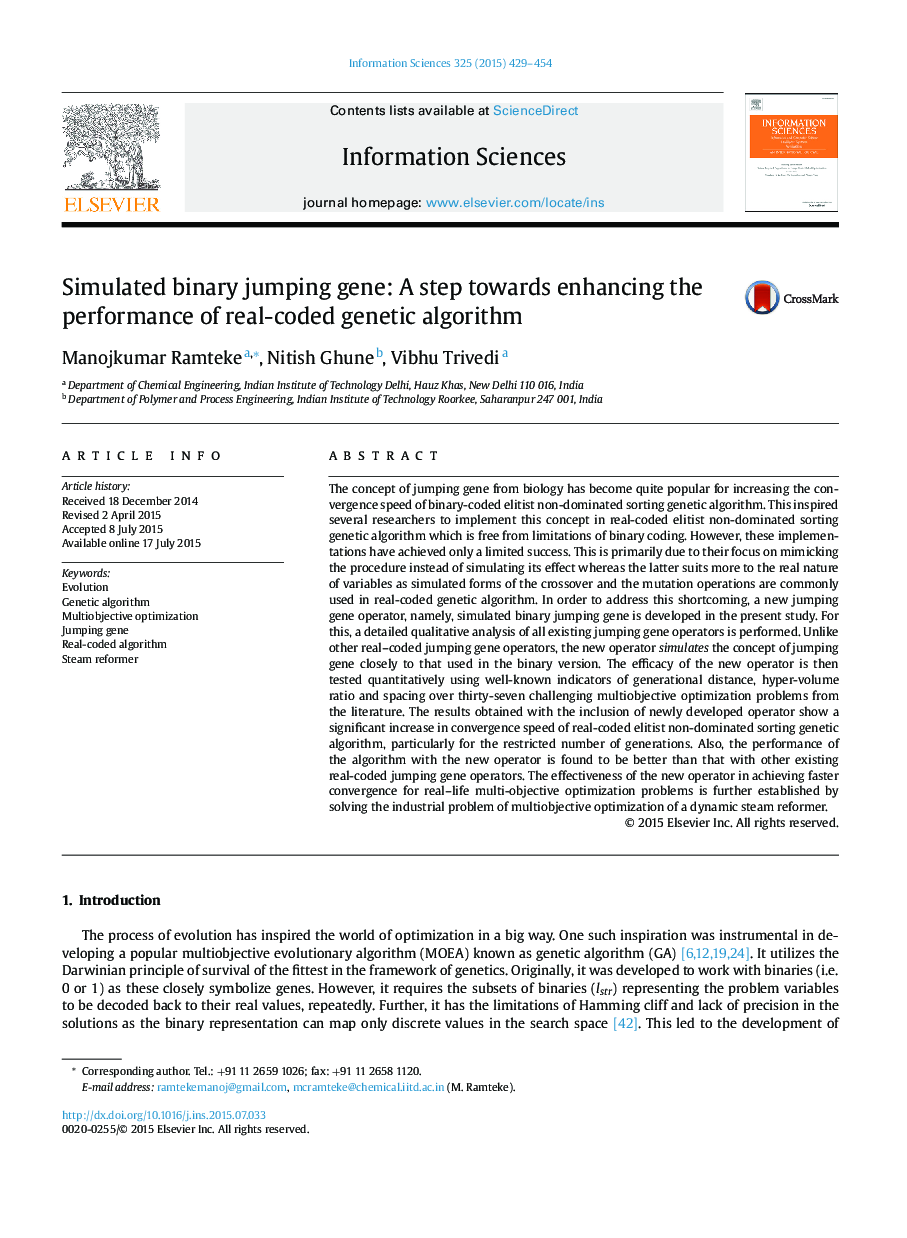| کد مقاله | کد نشریه | سال انتشار | مقاله انگلیسی | نسخه تمام متن |
|---|---|---|---|---|
| 6857638 | 665570 | 2015 | 26 صفحه PDF | دانلود رایگان |
عنوان انگلیسی مقاله ISI
Simulated binary jumping gene: A step towards enhancing the performance of real-coded genetic algorithm
ترجمه فارسی عنوان
شبیه سازی ژن جهش باینری: گام به سوی افزایش عملکرد الگوریتم ژنتیک واقعی
دانلود مقاله + سفارش ترجمه
دانلود مقاله ISI انگلیسی
رایگان برای ایرانیان
کلمات کلیدی
سیر تکاملی، الگوریتم ژنتیک، بهینه سازی چند منظوره، ژن پریدن، الگوریتم واقعی الگوریتم، اصلاح کننده بخار،
ترجمه چکیده
مفهوم پریدن ژن از زیست شناسی برای افزایش سرعت همگرا الگوریتم ژنتیک مرتب سازی غالب غالب نخبه گانه با دودویی کدگذاری شده است. این الهام گرفته از چندین محقق برای پیاده سازی این مفهوم در الگوریتم ژنتیک مرتب سازی نخبه گرا نخبه گرا که از محدودیت های برنامه نویسی دودویی آزاد است. با این حال، این پیاده سازی تنها یک موفقیت محدود را به دست آورده اند. این در درجه اول به دلیل متمرکز شدن آنها در تقلید از روش به جای شبیه سازی اثر آن است در حالی که دوم بیشتر به ماهیت واقعی متغیرها به عنوان شکل شبیه سازی شده از متقاطع مناسب است و عملیات جهش معمولا در الگوریتم ژنتیک واقعی استفاده می شود. به منظور رفع این نقص، یک اپراتور ژن پریدن جدید، یعنی ژن جهش دوتایی شبیه سازی شده در این مطالعه، توسعه یافته است. برای این، یک تجزیه و تحلیل کیفی دقیق از تمام اپراتورهای پرش موجود موجود انجام می شود. اپراتور جدید بر خلاف دیگر اپراتورهای جهش پرتقال واقعی، مفهوم پریدن ژن را نزدیک به آنچه که در نسخه باینری استفاده می شود، شبیه سازی می کند. سپس کارآیی اپراتور جدید با استفاده از شاخص های شناخته شده فاصله، نسبت بیش از حد نسبی و فاصله بیش از سی و هفت مسئله بهینه سازی چند منظوره به چالش کشیدن از ادبیات، کمی سنجیده می شود. نتایج به دست آمده با استفاده از اپراتورهای تازه توسعه یافته نشان می دهد که افزایش قابل توجهی در سرعت همگرا الگوریتم ژنتیک طبقه بندی نخبه گرا نخبه گرا، به ویژه برای تعداد محدود نسل. همچنین عملکرد الگوریتم با اپراتور جدید بهتر از آن است که با دیگر اپراتورهای پرشده موجود پر رمزگذاری موجود باشد. اثربخشی اپراتور جدید در دستیابی به همگرایی سریعتر برای مسائل بهینه سازی چند هدفه واقعی در زندگی، با حل مسئله صنعتی بهینه سازی چند هدفه یک اصلاح کننده بخار پویا، به اثبات رسیده است.
موضوعات مرتبط
مهندسی و علوم پایه
مهندسی کامپیوتر
هوش مصنوعی
چکیده انگلیسی
The concept of jumping gene from biology has become quite popular for increasing the convergence speed of binary-coded elitist non-dominated sorting genetic algorithm. This inspired several researchers to implement this concept in real-coded elitist non-dominated sorting genetic algorithm which is free from limitations of binary coding. However, these implementations have achieved only a limited success. This is primarily due to their focus on mimicking the procedure instead of simulating its effect whereas the latter suits more to the real nature of variables as simulated forms of the crossover and the mutation operations are commonly used in real-coded genetic algorithm. In order to address this shortcoming, a new jumping gene operator, namely, simulated binary jumping gene is developed in the present study. For this, a detailed qualitative analysis of all existing jumping gene operators is performed. Unlike other real-coded jumping gene operators, the new operator simulates the concept of jumping gene closely to that used in the binary version. The efficacy of the new operator is then tested quantitatively using well-known indicators of generational distance, hyper-volume ratio and spacing over thirty-seven challenging multiobjective optimization problems from the literature. The results obtained with the inclusion of newly developed operator show a significant increase in convergence speed of real-coded elitist non-dominated sorting genetic algorithm, particularly for the restricted number of generations. Also, the performance of the algorithm with the new operator is found to be better than that with other existing real-coded jumping gene operators. The effectiveness of the new operator in achieving faster convergence for real-life multi-objective optimization problems is further established by solving the industrial problem of multiobjective optimization of a dynamic steam reformer.
ناشر
Database: Elsevier - ScienceDirect (ساینس دایرکت)
Journal: Information Sciences - Volume 325, 20 December 2015, Pages 429-454
Journal: Information Sciences - Volume 325, 20 December 2015, Pages 429-454
نویسندگان
Manojkumar Ramteke, Nitish Ghune, Vibhu Trivedi,
